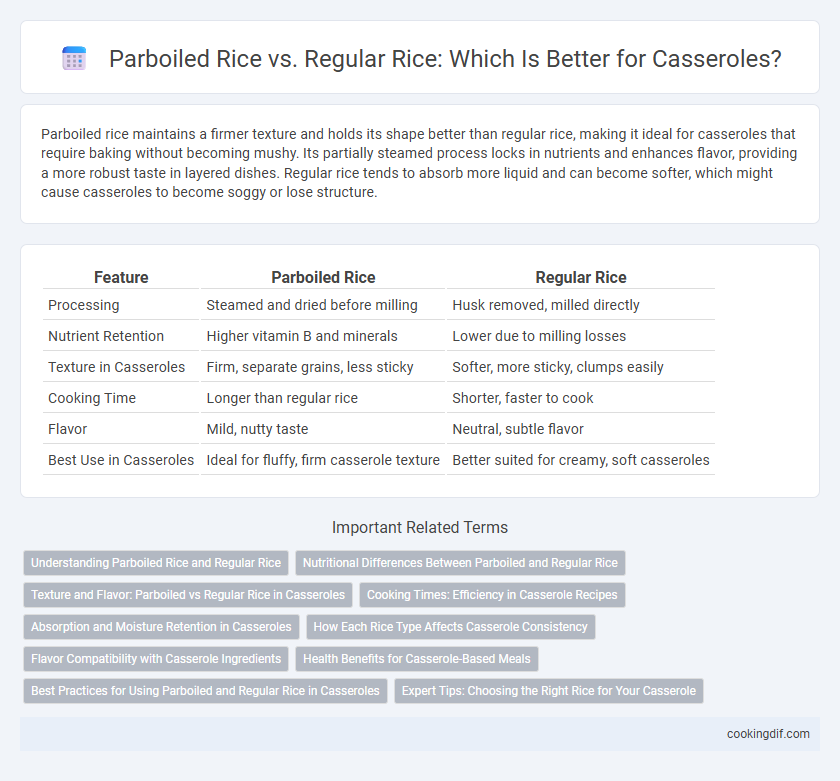Parboiled rice maintains a firmer texture and holds its shape better than regular rice, making it ideal for casseroles that require baking without becoming mushy. Its partially steamed process locks in nutrients and enhances flavor, providing a more robust taste in layered dishes. Regular rice tends to absorb more liquid and can become softer, which might cause casseroles to become soggy or lose structure.
Table of Comparison
| Feature | Parboiled Rice | Regular Rice |
|---|---|---|
| Processing | Steamed and dried before milling | Husk removed, milled directly |
| Nutrient Retention | Higher vitamin B and minerals | Lower due to milling losses |
| Texture in Casseroles | Firm, separate grains, less sticky | Softer, more sticky, clumps easily |
| Cooking Time | Longer than regular rice | Shorter, faster to cook |
| Flavor | Mild, nutty taste | Neutral, subtle flavor |
| Best Use in Casseroles | Ideal for fluffy, firm casserole texture | Better suited for creamy, soft casseroles |
Understanding Parboiled Rice and Regular Rice
Parboiled rice undergoes a unique steaming process that drives nutrients from the bran into the grain, making it more nutritious and less sticky compared to regular rice. Regular rice, typically milled and polished, loses some vitamins but retains a softer texture ideal for creamy casseroles. Choosing parboiled rice in casseroles results in firmer grains that hold shape well, while regular rice offers a fluffier consistency that absorbs flavors differently.
Nutritional Differences Between Parboiled and Regular Rice
Parboiled rice retains more nutrients such as vitamin B6, niacin, and magnesium compared to regular white rice due to the steaming process prior to milling, which drives nutrients from the bran to the grain. It has a lower glycemic index, making it a better option for blood sugar control and sustained energy release in casseroles. Regular white rice loses many nutrients during polishing, resulting in lower fiber content and fewer vitamins essential for metabolic health.
Texture and Flavor: Parboiled vs Regular Rice in Casseroles
Parboiled rice retains a firmer, less sticky texture in casseroles, providing distinct grain separation and a slightly nutty flavor that enhances savory dishes. Regular rice tends to become softer and more absorbent, creating a creamier consistency that blends seamlessly with sauces and ingredients. Flavor profiles differ as parboiled rice offers subtle earthiness, while regular rice maintains a milder, more neutral taste suitable for diverse casserole recipes.
Cooking Times: Efficiency in Casserole Recipes
Parboiled rice cooks faster than regular rice, reducing overall casserole preparation time by 10-15 minutes. Its firmer texture prevents overcooking and ensures a consistent, fluffy result in baked dishes. Regular rice requires longer simmering and careful timing to avoid mushiness in casseroles.
Absorption and Moisture Retention in Casseroles
Parboiled rice is superior in casseroles due to its enhanced absorption and moisture retention capabilities, stemming from the steaming process during its production that gelatinizes the starch. This allows it to absorb more liquid without becoming mushy, maintaining a firmer texture compared to regular rice. Regular rice tends to release more starch and absorb less liquid, often resulting in a softer, sometimes overcooked consistency in casserole dishes.
How Each Rice Type Affects Casserole Consistency
Parboiled rice retains more firmness and separates easily during cooking, preventing casseroles from becoming overly mushy, which results in a firmer, grainier texture. Regular white rice tends to absorb more liquid and break down faster, creating a softer, creamier consistency ideal for casseroles requiring a richer, cohesive structure. Choosing parboiled rice supports recipes needing structure and distinct grains, while regular rice is suited for silky, blended casserole textures.
Flavor Compatibility with Casserole Ingredients
Parboiled rice offers a nuttier flavor and firmer texture, making it ideal for hearty casseroles with robust ingredients like meats, cheeses, and savory vegetables. Regular rice has a milder taste and softer consistency, complementing delicate casseroles featuring creamy sauces, herbs, and light vegetables. Choosing parboiled rice enhances flavor depth in bold casseroles, while regular rice maintains subtlety in gentle flavor combinations.
Health Benefits for Casserole-Based Meals
Parboiled rice retains more nutrients such as vitamins B1, B3, and B6 compared to regular white rice, making it a healthier option for casserole-based meals. Its lower glycemic index helps stabilize blood sugar levels, which benefits individuals managing diabetes or weight. The firmer texture of parboiled rice also prevents casseroles from becoming overly mushy, enhancing both nutrition and dish quality.
Best Practices for Using Parboiled and Regular Rice in Casseroles
Parboiled rice retains more nutrients and has a firmer texture, making it ideal for casseroles that require rice to hold shape during baking. Regular rice absorbs flavors more readily but can become mushy if overcooked in casseroles, so careful timing is essential. For best results, rinse regular rice before use and adjust liquid ratios to maintain desired consistency in the casserole.
Expert Tips: Choosing the Right Rice for Your Casserole
Parboiled rice stands out for casseroles due to its firmer texture and resistance to becoming mushy during baking, making it ideal for dishes requiring distinct grain separation. Regular rice offers a softer, more tender bite, which can be preferred in creamier, comfort-style casseroles. Experts recommend parboiled rice when structural integrity is key, while regular rice suits recipes needing a smoother, more cohesive texture.
Parboiled rice vs regular rice for casseroles Infographic

 cookingdif.com
cookingdif.com